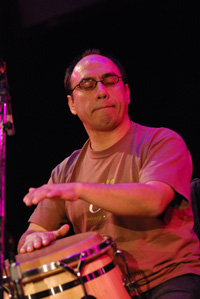
Photo by Phil Farnsworth
Ernesto Diaz
Position
Assistant Professor
Affiliated Departments
Telephone
617-747-8297
For media inquiries, please contact Media Relations
Career Highlights
- Performances with Latin pop star Gloria Estefan, the Boston Pops, as well as Cuban legends such as Cachao Lopez, Eliades Ochoa, Toumani Diabate, Paquito D’Rivera, and Oriente Lopez
- Led concerts with visiting artists such as Changuito, Giovanni Hidalgo, Horacio Hernandez, Francisco Mela, and Roberto Vizcaino
- Music featured in movies The Blue Diner and Casa de los Babys and on radio with WGBH’s La Plaza
- Recordings include Gonzalo Grau y La Clave Secreta album Frutero Moderno and Keith Lockhart and the Boston Pops album The Latin Album
Awards
- Grammy nomination for Best Tropical Latin Album of the Year for Frutero Moderno
- Latin Grammy nomination for Best Pop Instrumental Album for The Latin Album
In Their Own Words
